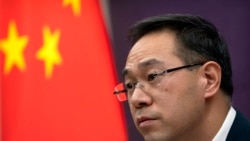Sino-U.S. trade tensions could flare up again as it appears China will miss its obligations under a nearly expired agreement that emerged from a dispute during the administration of former U.S. President Donald Trump, analysts said.
The Economic and Trade Agreement signed by the two superpowers in January 2020 is set to end December 31. Trade observers say China has not complied with a clause that obligates it to buy imports of manufactured goods, farm products, energy products and certain services from the U.S. at a total of $200 billion more than the 2017 total. China purchased $186 billion in goods and services in 2017 before the trade war, according to U.S. government figures.
China has had trouble complying because of delays in Chinese aircraft orders from the U.S. and pandemic-related setbacks, said Matthew Goodman, senior vice president for economics with the Washington-based Center for Strategic & International Studies, a research group.
"I do think that the Biden administration is going to follow through on this agreement and hold China to account," Goodman told VOA. "I don't see any reason that they're going to change tack."
China had met just 62% of its import purchasing goal as of October, according to an analysis by Chad Bown, senior fellow with the Peterson Institute for International Economics, another research organization in Washington.
U.S. manufacturers may have lacked capacity as well to meet the demand for China-bound goods, said Bashar Malkawi, a University of Arizona law professor who specializes in trade. China's pandemic-era border closures further harmed U.S. exports, he said.
The nearly four-year-old trade dispute launched by Trump over the Sino-U.S. trade imbalance has placed tariffs on $550 billion worth of goods, including $350 billion originating in China. The dispute also led to a chill in broader two-way relations that would run through Trump's term.
"The environment between these two countries is toxic," Malkawi said. "Trade war and mistrust have been raging since 2018 and will not ease for the foreseeable future."
What's next
The U.S. trade representative's office did not reply to a query for this report asking whether China had lived up to the agreement. Its website does not indicate what might happen in 2022.
U.S. Trade Representative Katherine Tai said in a speech at the Center for Strategic & International Studies in October that the U.S. government will discuss with China its "performance" and that under the agreement, China had made "commitments that benefit certain American industries, including agriculture, that we must enforce."
The U.S. side will "work to enforce the terms of phase one," she added, referring to the terms of the deal.
Tai indicated that the United States had yet to review the agreement.
China hopes the U.S. government "will create favorable conditions for the two nations to expand trade cooperation," Ministry of Commerce spokesperson Gao Feng said Thursday, as quoted by the China Daily news website.
Gao said China had "exerted strenuous efforts to offset negative impact from factors such as the COVID-19 pandemic, the global economic recession and the constraint of supply chain" to carry out the agreement, according to the website.
China is the largest goods trading partner of the United States, with $559.2 billion passing both ways in 2020, according to the trade representative's office.
U.S. goods and services trade with China totaled about $615.2 billion in 2020, with imports at $450.4 billion.
Expiration of the trade deal potentially gives China an opening to negotiate for buying the U.S. goods that it needs, said Song Seng Wun, an economist in the private banking unit of Malaysian bank CIMB. China traditionally buys U.S. foodstuffs, civilian aircraft and aircraft parts. Its tech firms depended on American supplies before the trade war as well.
"I suppose it always boils down to what China wants to buy and what the U.S. wants to sell," Song said. "China can be more selective in buying. Politics matters more at this point."
Chinese officials might consider asking to buy the U.S. goods that China needs most, possibly swapping out the ones in today's agreement, said Stuart Orr, School of Business head at Melbourne Institute of Technology in Australia.
"I think China is probably going to have to try to renegotiate, and the reason probably motivating that will be the volume of supplies of some of the things that it actually needs," he said.













